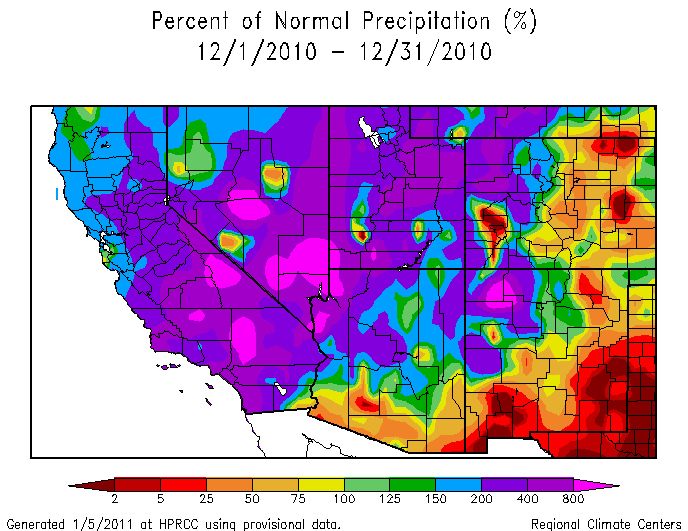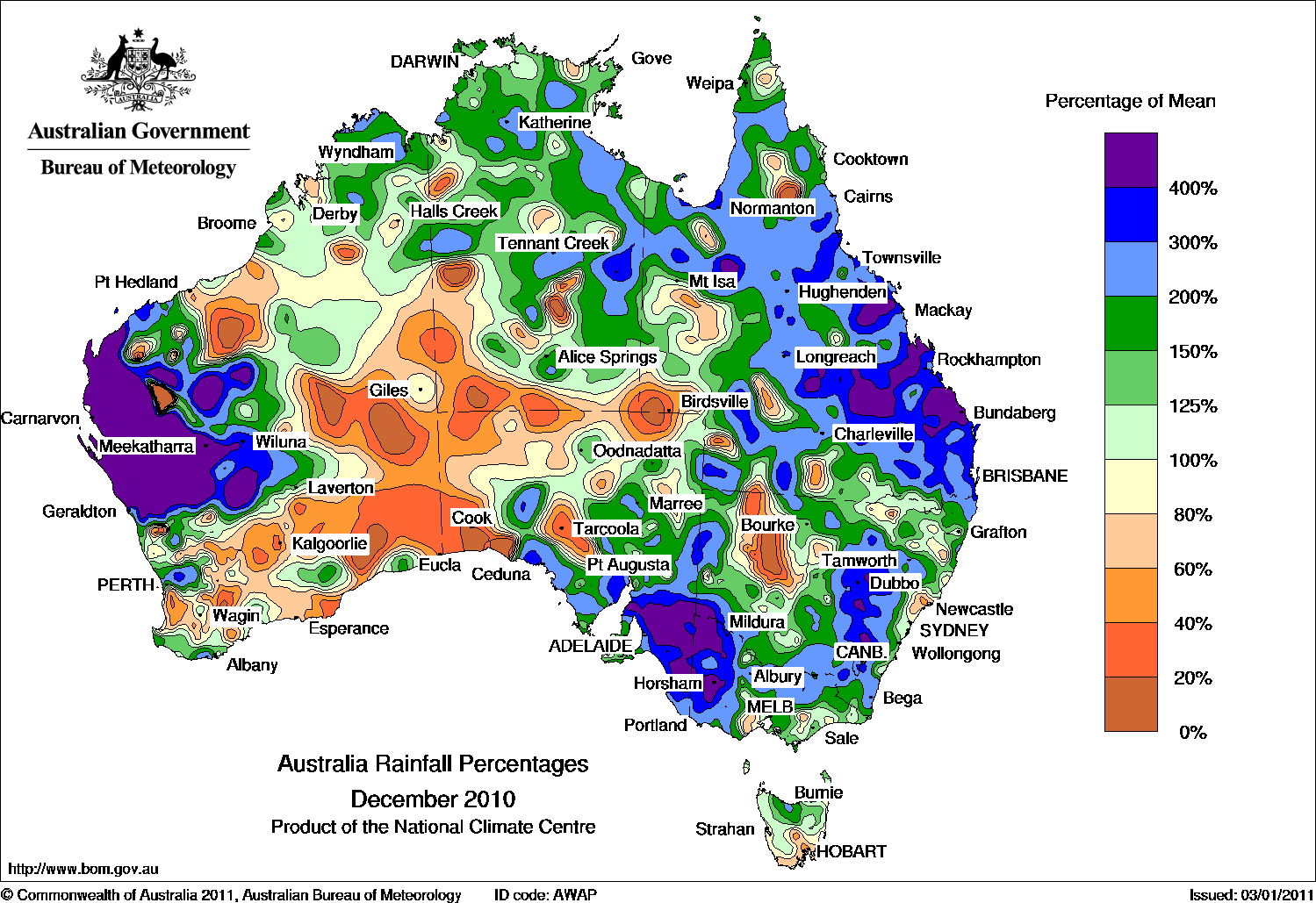Updated 14 January 2011

At the beginning of December, Somalia's central region of Mudug was entrenched in a severe drought. According to a local elder, there were very little Gu rains (rains from April–June) and a total failure of the Deyr rains (October–December) in 2010. At least 5,000 families were affected in the region. The hardest-hit areas were those bordering northeastern Kenya and southeastern Ethiopia, including settlements in Towfiq, Eil Dhanane, Dhinowda, and Afbarwaqo areas.
During the last three months of 2010, rainfall in eastern China's Shandong province was 86 percent below average, receiving only 0.35 inches (9 mm) of rain. The lack of precipitation during this period enhanced drought conditions, resulting in the worst drought in 50 years for the region and leaving about 240,000 people without adequate drinking water. In addition, about 1.84 million hectares of cropland was affected by the drought. To the west, Shanxi province received 0.07 inches (1.7 mm) of rain, 89 percent below average.
A forest fire—thought to be the largest in Israel's history—broke out in the Carmel Mountains near Haifa in the northern part of the country on December 2nd. Fueled by high winds and dry conditions, at least 41 people were killed after a bus burst into flames and 17,000 were evacuated as the fire destroyed more than 12,300 acres (5,000 hectares) of land, including an estimated five million trees and 74 buildings. The fire was declared to be "under control" on December 5th, after 24 aircraft, including the world's largest firefighting aircraft—a Boeing 747 Evergreen SuperTanker—were brought in to help battle the blaze.

A week of copious rainfall brought flooding to the Balkans during the first week in December. More than 12,000 people were evacuated in northern Albania and 35,000 acres (14,000 hectares) of farmland were destroyed. Locally, the River Drina rose to its highest level in more than a century. Authorities were forced to open emergency dam gates and release the water into the Shkodra lake, which, along with the rainfall, caused the flooding. Streets in the town of Shkodra were inundated with six and a half feet (two meters) of water. The only ways into or out of town were by boat or helicopter. Bosnia, Serbia, and Montenegro declared a state of emergency—the River Drina runs along the borders of all three countries. In northern Bosnia, the heavy rains triggered a landslide in the city of Tuzla that killed three people. In southern Croatia, the River Neretva reached its highest level in 50 years, flooding 700 homes in the town of Metkovic.
Weeks of torrential rainfall in Central and South America heavily impacted Venezuela, Colombia, and Panama. The heavy rains caused flooding and landslides that killed at least 34 people in Venezuela and caused more than 100,000 to flee their homes. The country's Caribbean coast was particularly hard hit. In Colombia, a landslide on December 5th killed at least 47 people and left an estimated 80 others missing in the city of Medellin in Antioquia province. The landslide was a product of Colombia's heaviest rains since record keeping began in 1969. Heavy rainfall and flooding in Panama killed 10 people and damaged over 2,500 homes. The downpours forced the Panama Canal to close on December 8th and 9th, the first time the canal closed due to weather conditions since its opening in 1914. The rainy season was particularly severe this year. The extreme conditions were attributed to the La Niña climatic phenomenon, where cooler-than-normal temperatures in the equatorial and central Pacific Ocean impact weather conditions in various parts of the world.
The "Pineapple Express"—a meteorological event where southwest winds bring warm, moist air to the U.S. West Coast—produced record rainfall to the Pacific Northwest during December 11th–12th. Seattle experienced record daily rainfall two days in a row. The Seattle-Tacoma International Airport recorded 1.42 inches (36 mm) of rain on the 11th, breaking the old daily record of 1.32 inches (34 mm) set in 1955. The next day, 2.19 inches (56 mm) fell, breaking the daily record of 1.70 inches (43 mm) set in 1966. The Stillaguamish River in western Washington state reached 21.06 feet (6.42 meters) at Arlington, tying the record set in November 2006. Flood stage for the river is 14 feet (4.3 meters). The storm system also brought record warmth to the area. On December 14th, the temperature at Seattle-Tacoma International Airport reached 57°F (13.9°C), breaking the old daily record of 55°F (12.8°C) set in 2004.
More storms—courtesy of the Pineapple Express—inundated California with rain and snow on December 17th–22nd. The week-long event brought average rainfall of 5–10 inches (125–250 mm) in coastal and valley areas of southwestern California and 10–18 inches (250–460 mm) to the nearby foothills and mountains. A total of 24.70 inches (627 mm) of rain was reported at Tanbark in Los Angeles County. Los Angeles International Airport—among several other locations—broke its daily precipitation record on both the 19th (2.23 inches [57 mm], surpassing the old record of 1.62 inches [41 mm] set in 1984) and the 20th (0.98 inches [25 mm], surpassing the previous record of 0.7 inches [18 mm] set in 1952). In addition to breaking its daily precipitation record of 2.80 inches (71 mm) on the 19th, besting the old record of 2.12 inches (54 mm) set in 1921, downtown Los Angeles (a different area than Los Angeles International Airport) recorded a total of 8.16 inches (207 mm) of rain during from the 15th–22nd, with almost all of the rainfall occurring during the latter five days. For the month, downtown Los Angeles experienced its second wettest December on record, with 10.23 inches (260 mm) total. Many other locations had their all-time wettest Decembers, including Los Angeles International Airport (8.83 inches [224 mm]), Long Beach Airport (10.41 inches [264 mm], and Oxnard (9.16 inches [233 mm]). Generally, rainfall was 300–600 percent above normal for the month in this region. Flooding and mudslides occurred in some areas, leading to the evacuation of 400 residents in San Juan Capistrano after a hillside collapse. The governor of California also declared a state of emergency in six counties. Fortunately no fatalities related to the storms were reported. Additionally, 208 inches (528 cm) of snow reportedly fell throughout the month at Mammoth Mountain ski resort, becoming the snowiest December on record at the resort since records began 1969; the old record was 139.8 inches (355 cm) set in 1971.
After weeks of heavy rainfall, Australia's attorney general declared 45 communities in eastern Australia disaster areas on December 9th. Four people were killed and thousands were forced to evacuate their homes as rivers overflowed their banks and caused major flooding. The worst weather, however, was reported to be in South Australia, where Adelaide had its wettest December day on record on the 7th. Almost two weeks later, on the 20th, 9.65 inches (245 mm) of rain fell over Carnarvon, a town located about 560 miles (900 km) north of Perth in Western Australia. Local media reported that the area experienced its worst flooding in 50 years. The Gascoyne River reached its highest levels ever recorded, breaking the previous record set in 1960. Please see the Tropical Cyclones section for information on the flooding effects in northeastern Australia due to Tropical Cyclone Tasha.
Torrential rains occurred during the last week in December in southern Egypt. Strong flood currents swept away a bus driving along a highway more than 100 miles (160 km) south of Cairo, killing 15 people. Further to the east, in Jeddah, Saudi Arabia—the country's second largest city—waist-high water flooded city streets, damaging homes and disrupting traffic.
Five days of steady rain in the eastern Philippines prompted officials to evacuate 4,000 people in at least five towns. Floodwaters led to two deaths in Manito township in Albay province.

A powerful cyclone brought torrential rains and strong winds to the eastern Mediterranean and the Middle East on December 11th–12th. At least five people were killed, shipping was disrupted in the Suez Canal, and a Moldovan cargo ship sank off the coast of Israel. Fortunately, the vessel's crew were rescued by a nearby Taiwanese ship. Waves up to 33 feet (10 meters) high were reported along the coast in Lebanon. In Israel, the winds knocked out power to hundreds of people and downed trees. Major highways in Jordan were closed as 55 mph (90 km/hr) winds kicked up sand, severely limiting visibility. On a positive note, the storm ended a lengthy drought in Lebanon, Syria, and Israel.
A strong storm system tore across the northeastern U.S. at the beginning of December. The storm, which spawned 11 tornadoes in the southeastern U.S. states of Alabama, Georgia, and South Carolina on November 30th, according to preliminary data from NOAA's Storm Prediction Center, barreled toward the Northeast. On December 1st, wind gusts as high as 70 mph (113 km/hr) toppled trees and caused tens of thousands of customers to lose power in the mid-Atlantic region, New York, Vermont, and Connecticut. At least three people were killed.
Unusually warm air fueled strong storms in the midwestern and southern U.S. on December 31st, producing high winds and a preliminary count of 53 tornadoes across five states. At least eight people were killed in Missouri and Arkansas and dozens of others were injured. In Mississippi, about 200 people were evacuated from the Jackson-Evers International Airport, where an EF-2 tornado crossed a runway. More detailed information is available in the NCDC December 2010 State of the Climate Tornadoes report.

Tropical Cyclone Tasha formed off the coast of northeastern Australia on December 24th. The storm made landfall early the next day between Cairns and Innisfail as a Category 1 cyclone with wind gusts of roughly 65 mph (105 km/hr) reported just offshore. Although the storm intensity quickly dissipated over land, it brought heavy rainfall to an already soaked region, resulting in more than an estimated $5 billion U.S. dollars in damages. The storm triggered flash floods, leading 41 local governments to declare disasters as mining and agricultural activities were disrupted. Some areas received about 20 inches (more than 500 mm) of rainfall from the 23rd–25th. Following its wettest spring (September–November) on record, the precipitation from Tropical Cyclone Tasha led to one of the most significant flooding events in Queensland's history as river catchments were overwhelmed in many areas, according to the Bureau of Meteorology. At least nine people were killed and up to 200,000 people were affected. The towns of Theodore and Condomine were completely evacuated. Residents of Rockhampton were also forced to leave as the town's river was expected to peak at 31 feet (9.4 meters) in early January, threatening 2,000–4,000 homes. Flooding closed more than 300 roads, including two major highways to the state capital of Brisbane. A vast area the size of France and Germany combined was inundated by the floodwaters. The rainfall from the storm, in combination with additional rainfall during the month led to Queensland's wettest December on record—an average of 8.25 inches (209.45 mm) across the state, well more than double the 1961–1990 December average of 3.25 inches (82.48 mm). The excessive rainfall was attributed to a strong La Niña.


European
Temperature Anomalies
1-16 December 2010
Image Credit: NOAA Earth System Research Laboratory
Cold Arctic air gripped western Europe during most of the first three weeks of December. Two major snowstorms, icy conditions, and frigid temperatures wreaked havoc across much of the region. Over the course of the period, airports in the UK, Germany, France, the Netherlands, Belgium, and Switzerland were forced to cancel or delay thousands of flights, stranding tens of thousands of passengers. Further, railways and bus services were disrupted, stranding thousands more, and thousands of schools were closed. The first storm that occurred at the beginning of the month was reported to be Britain's heaviest and most widespread snow since 1993. Denmark mobilized its army to assist emergency vehicles in the southeastern portion of the country. On the 3rd, severe frost left 150,000 people without heat in the southern Polish city of Czestochowa. Paris, France—a city that typically sees rain—received 4 inches (10 cm) of snow on December 8th. Bus services were halted and the Eiffel Tower was closed for a day. That same day, Scotland saw its heaviest snowfall since 1963 and subsequently called on its army to help clear snow and ice. Thirty inches (75 cm) of snow fell in parts of the capital city of Edinburgh. Another round of heavy snow fell across Europe on the 17th–18th, forcing thousands more flight cancellations. According to its website, Heathrow Airport in London—the world's busiest international airport—was forced to close on the 18th as five inches of snow reportedly fell in one hour. Train and bus cancellations and delays in the UK, Germany, France, Belgium, and the Netherlands compounded woes for holiday travelers. Italy's island of Capri recorded its first snowfall in 25 years. Snow and icy conditions along with cold temperatures continued to wreak havoc across northern Europe on the 19th–20th as hundreds more flights were cancelled, rail services were disrupted, and schools were closed. Media reports said that Northern Ireland was experiencing its worst weather in 25 years. On the 18th, the temperature dropped to -0.4°F (-18°C) at Castlederg, County Tyrone, the lowest temperature ever recorded in Northern Ireland. The previous record low was 0.5°F (-17.5°C), set on January 1st, 1979 in Magherally. Within the past month, 114 people died in Poland due to the frigid temperatures and dozens of others were killed in weather-related accidents across Europe, according to multiple media reports. By the end of the month, the UK had experienced its coldest December in more than 100 years, with average temperatures about 9°F (5°C) below normal. The harsh winter weather was attributed to a negative Arctic Oscillation, which is a climate pattern that influences weather in the Northern Hemisphere. A very persistent, strong ridge of high pressure, or 'blocking system', near Greenland allowed cold Arctic air to slide south into Europe.
Europe was not the only region in the Northern Hemisphere affected by the Arctic Oscillation. A large snow storm and frigid temperatures affected much of the Midwest United States on December 10th–13th. The storm brought 17.1 inches (43.1 cm) of snow to the Minneapolis/St. Paul region on the 10th–11th. According to the Minnesota State Climatology Office, this was the largest December snow storm for the area on record, the largest for any winter month since 1991, and the fifth largest since records began in 1891. The snow proved to be too much for the Minneapolis Metrodome's inflatable roof; it collapsed under the heavy weight of the frozen precipitation on the 12th. Eau Claire, Wisconsin received 22.0 inches (55.9 cm) of snow on the 11th, its highest single calendar day snowfall total in history. In the U.S., the storm also wreaked havoc across Indiana and Michigan. At least 16 people were killed in weather-related accidents. The storm moved east into southern Ontario, Canada, where two days of blizzard conditions stranded hundreds of vehicles on highways and secondary roads. One of the motorists reportedly died of hypothermia.
A winter storm swept across parts of the Southeast U.S. on December 15th, bringing a mixed bag of snow, sleet, and freezing rain, making for treacherous travel conditions. At least eight people were killed in Alabama, Mississippi, and North Carolina in weather-related traffic fatalities. Schools were forced to close and thousands of residents lost power in North Carolina and Virginia. The winter storm also impacted Missouri, Tennessee, Kentucky, Ohio, West Virginia, Delaware, Maryland, and Washington D.C.
The same storm that wreaked havoc in the U.S. Southwest, Midwest, and South also brought up to 32 inches (81 cm) of snow and created blizzard conditions across parts of the eastern U.S. on December 25th–27th, a major national holiday weekend. A state of emergency was declared in North Carolina, Virginia, Maryland, New Jersey, Massachusetts, and Maine. In New York City, up to 24.5 inches (62 cm) of snow fell, effectively shutting down rail lines, major airports, and bus services. Thousands of flights were cancelled and stranded subway riders were forced to spend a night in unheated train cars. One person was reported killed in Maine due to the weather conditions.

In early December, NOAA proposed listing four subspecies of the ringed seal—Arctic, Okhostk, Baltic, and Lagoda—and two subspecies of bearded seals as threatened under the Endangered Species Act. These ringed seals are found in the Arctic Basin and North Atlantic, and bearded seals are in the Pacific Ocean. NOAA cited threats posed by declining sea ice and reduced snow cover. Ringed seal pups are typically born in snow caves during spring and are vulnerable to freezing and predators without them. These seals only produce a single offspring per year, which may limit their ability to respond to changing environmental conditions such as sea ice melt and snow cover. Bearded seals need sea ice, particularly during reproduction and molting stages. Models predict that the seasonal ice will be substantially reduced during this century, thus impacting the potential survival of the ringed seals.
 NOAA's National Centers for Environmental Information
NOAA's National Centers for Environmental Information








